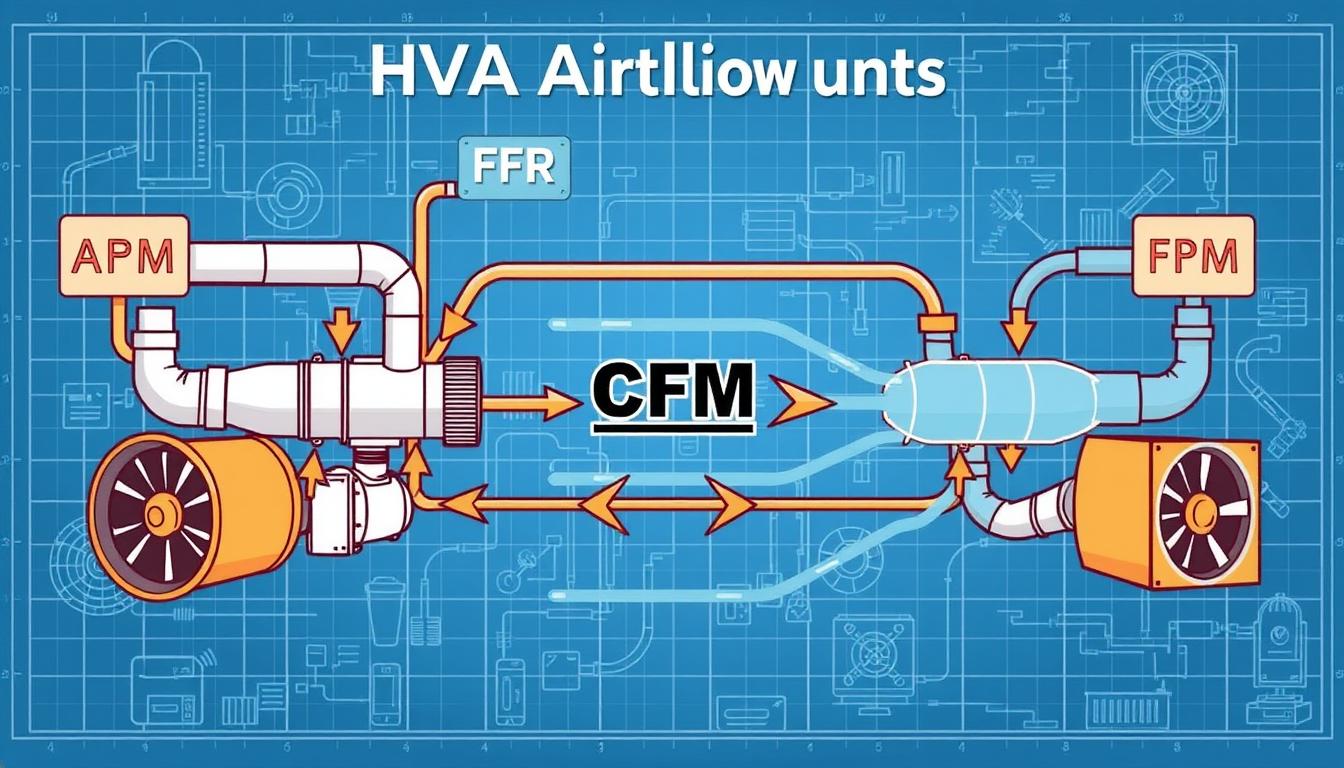Understanding air flow measurements in HVAC systems is key. The connection between FPM (feet per minute) and CFM (cubic feet per minute) is vital. These units help design, install, and maintain HVAC systems for proper air flow and ventilation. We’ll look at converting FPM to CFM, give examples, and talk about why accurate measurements matter.
Key Takeaways
- FPM (feet per minute) measures air flow speed, while CFM (cubic feet per minute) measures air flow volume.
- To change from FPM to CFM, multiply the FPM by the ductwork or air stream’s area in square feet.
- Getting FPM and CFM right is crucial for HVAC system design, installation, and improvement. It ensures good air flow and ventilation.
- Knowing how FPM and CFM relate helps HVAC experts find and fix air flow problems in current systems.
- Correctly figuring out FPM and CFM is key to making sure HVAC systems follow building codes and save energy.
What is FPM and CFM?
When we talk about airflow in HVAC systems, FPM and CFM are key. FPM means feet per minute and shows how fast air moves. CFM is short for cubic feet per minute and tells us how much air is moved over time.
It’s important to know the difference between FPM and CFM for HVAC systems. FPM shows air speed, while CFM shows air volume. This helps in designing and fixing HVAC systems.
| Metric | Definition | Measurement |
|---|---|---|
| FPM (Feet per Minute) | Describes the velocity or speed of air movement | Measures the length per unit of time |
| CFM (Cubic Feet per Minute) | Describes the volume of air being moved | Measures the volume per unit of time |
Knowing FPM and CFM helps HVAC experts make systems work better. They can design and maintain systems for the best airflow and performance.
How to Convert FPM to CFM?
Working with HVAC systems means knowing the difference between FPM and CFM. FPM shows air speed, while CFM measures air volume. To switch between them, multiply the FPM by the area’s square feet.
The formula for this conversion is straightforward:
CFM = FPM * A
“A” is the area in square feet. For instance, with 2,000 FPM and a 2×3 feet duct (6 square feet), the CFM is:
CFM = 2,000 FPM * 6 sq ft = 12,000 CFM
This conversion is key for sizing and balancing HVAC systems right. Getting CFM calculations right helps control temperature, humidity, and air quality.
Key Considerations for FPM to CFM Conversion
- Measure the duct or opening’s area in square feet.
- Find the air velocity in FPM, either by measuring or calculating.
- Use the formula: CFM = FPM * A.
- Round the result to the nearest whole number for use.
| FPM | Duct Size (ft) | Duct Area (sq ft) | CFM |
|---|---|---|---|
| 1,500 | 2 x 3 | 6 | 9,000 |
| 2,000 | 2 x 3 | 6 | 12,000 |
| 2,500 | 2 x 3 | 6 | 15,000 |
Knowing how to convert FPM to CFM is vital for HVAC pros. This skill ensures your systems meet airflow needs for best performance and comfort.
How many FPM are in a CFM?
FPM (feet per minute) and CFM (cubic feet per minute) measure different things. FPM shows air speed, while CFM shows air volume. They are not the same thing.
You can’t directly change FPM to CFM or vice versa. But, you can figure out FPM from CFM if you know the area. The formula to do this is:
FPM = CFM / A
Where A is the area in square feet. This lets you turn air volume (CFM) into air speed (FPM).
Key Considerations:
- FPM measures air speed, while CFM measures air volume
- To calculate FPM from CFM, you need to know the cross-sectional area (in square feet)
- The formula is: FPM = CFM / Area (in square feet)
- Understanding the relationship between FPM and CFM is crucial for HVAC air flow measurement and system design
| Air Flow Measurement Unit | Measure | Formula |
|---|---|---|
| FPM (Feet per Minute) | Air Velocity | FPM = CFM / Area (sq ft) |
| CFM (Cubic Feet per Minute) | Air Volume | CFM = FPM * Area (sq ft) |
Knowing how FPM and CFM relate helps HVAC experts. They can measure and design air flow systems better. This ensures good air circulation, ventilation, and energy use.
Calculating FPM from Velocity Pressure
Finding the air flow velocity in feet per minute (FPM) is key in HVAC work. You can use the formula: FPM = 4005 x √ΔP. Here, ΔP is the Velocity Pressure, measured by a special device. This formula helps you figure out air velocity from the Velocity Pressure reading.
Understanding Velocity Pressure
Velocity Pressure, or ΔP, is a vital term in HVAC. It shows the pressure air moves with. This pressure is measured in inches of water column (in-WC). Knowing this, you can use the formula to find the FPM. FPM is important for designing and checking HVAC systems.
Calculating FPM from Velocity Pressure
The formula to change Velocity Pressure to FPM is easy:
FPM = 4005 x √ΔP
Here:
– FPM is the air flow speed in feet per minute
– ΔP is the Velocity Pressure in inches of water column (in-WC)
Just put the Velocity Pressure value into this equation. You’ll get the air flow speed in FPM. This is a key number for HVAC calculations and terminology.
Getting HVAC calculations right and knowing HVAC terminology well is crucial. It helps in designing, installing, and keeping HVAC systems running well. Knowing how to turn velocity pressure into FPM is a basic skill for HVAC pros. It helps them make sure systems work well and use energy wisely.
Example Calculation of CFM from FPM
It’s important to know how FPM (feet per minute) and CFM (cubic feet per minute) relate. This is key in designing HVAC systems. Let’s look at an example to see how to change FPM to CFM.
Calculating CFM from FPM
Let’s say we have a Velocity Pressure of 0.45 inches of water column (in-WC). Using the formula FPM = 4005 x √ΔP, where ΔP is the Velocity Pressure, we find the FPM is 2,686 feet per minute.
Now, let’s say the duct size is 20 inches by 20 inches. This means the area is 2.78 square feet. To change FPM to CFM, we use the formula CFM = FPM * A, where A is the duct area in square feet. With the values plugged in, we get:
CFM = 2,686 FPM * 2.78 sq ft = 1,322 CFM
This example shows how to find the cubic feet per minute (CFM) from feet per minute (FPM) and duct size. Knowing these HVAC calculations is vital for designing systems that work well.
Importance of Proper CFM
Keeping the right HVAC system performance and volume per time is key for your HVAC to work well. The correct air flow helps control temperature, humidity, and air quality inside. If CFM is off, you might face uncomfortable spaces or waste energy.
What is the impact of improper CFM on HVAC system performance?
Wrong CFM can really affect your HVAC system. Too little air flow can cause uneven temperatures, poor humidity, and bad air quality. Too much air flow wastes energy, raises costs, and might damage your system.
How does HVAC design affect the optimal CFM?
The best CFM for your HVAC depends on your building’s design and needs. You need to think about room size, how many people are there, and how much heat it needs. This helps figure out the right volume per time for comfort and health.
What are the consequences of inadequate CFM in an HVAC system?
Not enough HVAC system performance can cause many problems. You might get hot or cold spots, high humidity, and use more energy. In bad cases, it can even damage your equipment and harm people’s health.
How can proper CFM optimization improve HVAC design and efficiency?
Getting the right volume per time for your HVAC makes it work better. It helps control temperature and humidity, cuts energy costs, and makes your equipment last longer. This makes your indoor space more comfortable and sustainable.

| Metric | Importance | Impact of Improper CFM |
|---|---|---|
| Temperature Control | Critical | Uneven temperature distribution, hot/cold spots |
| Humidity Control | Essential | High or low humidity levels, poor indoor air quality |
| Energy Efficiency | Significant | Increased energy consumption, higher operating costs |
| Equipment Lifespan | High | Potential for equipment damage and premature failure |
HVAC System Design and CFM Requirements
When designing an HVAC system, the cubic feet per minute (CFM) is key. Designers figure out the needed CFM based on the building’s size, how many people will be there, and the air quality they want. Getting the CFM right is crucial for keeping the air comfortable and clean.
Right CFM helps HVAC equipment work well. If CFM is too low, the air won’t move enough. This can cause uneven heating and cooling and make people uncomfortable. But, if CFM is too high, it wastes energy and costs more to run.
What factors influence HVAC system design and CFM requirements?
- Building size and square footage
- Occupancy levels and anticipated usage patterns
- Desired temperature and humidity levels
- Ventilation requirements for indoor air quality
- Insulation, windows, and other building envelope characteristics
How do HVAC designers calculate the necessary CFM?
HVAC designers use standards, codes, and software to figure out CFM. They look at the building’s size, how many people will be there, and what the air should be like. This ensures the HVAC system is the right size for comfort and air quality.
What are the consequences of an improperly sized HVAC system?
If CFM is too low, the air won’t move enough. This can cause uneven heating and cooling and make people uncomfortable. If CFM is too high, it wastes energy and costs more to run.
How can HVAC professionals ensure the system meets CFM requirements?
- Carefully calculate the building’s square footage, occupancy, and desired environmental conditions
- Use industry standards and specialized software to determine the appropriate CFM
- Select HVAC equipment with the necessary capacity to meet the CFM requirements
- Regularly test and balance the HVAC system to ensure it is operating within the designed CFM range
By focusing on HVAC design and CFM, building owners and HVAC pros can make sure the space is comfortable, energy-efficient, and has good air quality.
Testing and Balancing HVAC Systems
As an HVAC professional, you are key to making sure systems work well. This means doing tests and balances. HVAC field engineers use special tools to check how your HVAC system is doing. They make sure it meets the CFM (cubic feet per minute) needs.
Measuring Velocity Pressure
The first thing to do is measure the velocity pressure in your HVAC system. A pitot tube is used for this. It helps find out the FPM (feet per minute) of the air flow. Then, they can see if the CFM matches the design.
Adjusting Fan Speeds
If the CFM doesn’t match, the engineer will adjust the fan speeds. This makes sure air flows well everywhere. It keeps your building comfortable and saves energy.
Testing and balancing are crucial for keeping your HVAC system right. With skilled field engineers, you know your system is working great. It gives you the comfort and efficiency you need.

Precision in HVAC Calculations
Precise HVAC calculations are key to good system design and operation. Small errors in airflow can affect comfort, energy use, and system performance. As a field engineer, your skills in math, physics, and HVAC are crucial for accurate HVAC calculations, HVAC design, and HVAC testing.
Why is Precision Important in HVAC Calculations?
HVAC systems must deliver the right air to each zone. This depends on room size, people, and heat. Precise measurements and calculations ensure the system works well. Without it, you might face issues like:
- Uneven temperatures and humidity
- Poor ventilation and air quality
- Higher energy costs
- Sooner equipment breakdowns
Key Factors in Precise HVAC Calculations
To get precise HVAC calculations, you need to focus on details and HVAC principles. Important factors include:
- Accurate velocity pressure (ΔP) measurements for airflow velocity (FPM)
- Correct duct or register area calculations for CFM
- System design aspects like duct size, fan performance, and equipment capacity
- Proper air balancing and adjustments for system operation
| Metric | Formula | Example |
|---|---|---|
| Airflow Velocity (FPM) | FPM = 4005 x √ΔP | With a Velocity Pressure of 0.45″ W.C., FPM = 4005 x √0.45 = 2,686 FPM |
| Volumetric Airflow (CFM) | CFM = FPM x Area | For a 20″ x 20″ duct with an area of 2.78 sq ft, CFM = 2,686 FPM x 2.78 sq ft = 1,322 CFM |
By using these methods, field engineers can make sure HVAC systems work well. This leads to better performance and comfort for everyone.
Conclusion
Knowing how feet per minute (FPM) and cubic feet per minute (CFM) relate is key for HVAC systems. It helps in designing, testing, and balancing them right. This ensures buildings have the right air flow, temperature, and air quality for comfort and health.
Being precise in HVAC calculations is vital. It’s based on understanding FPM and CFM well. This precision is the base for HVAC systems that work well and save energy. It’s important to measure and convert air flow data accurately to optimize HVAC units and meet standards.
By knowing how to convert FPM to CFM, HVAC experts can create better systems. These systems make indoor spaces comfortable, healthy, and energy-saving. This skill is essential in the HVAC field and is very important.





0 Comments